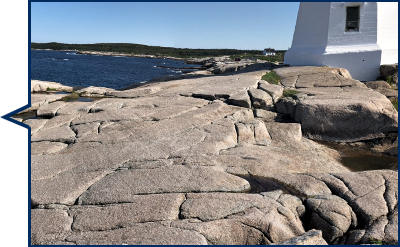- Why Mining Matters
- Jobs
- Safety
- Environment & Operations
- FAQ
- Links
- Fun Stuff

Why does the granite at Peggy’s Cove have so many cracks?!
The rocks at Peggy’s Cove began 470 million years ago as mud and sand in a deep ocean basin near ancient Africa. They built up and were eventually compacted into shale and sandstone. As tectonic plate movement caused North Africa and North America to collide 400 million years ago, the shale and sandstone were squeezed between the two continents and heat and pressure transformed them into slate and quartzite.

Heat from the continental collision also melted rock at the base of earth’s crust 375 million years ago. The molten granite was less dense than the solid rocks around it so it rose through the earth’s crust like a piece of wood rises through water. As it rose and got further from the heat deep inside the earth, it cooled and solidified several kilometres below earth’s surface.
Uplift (upward pressure) from the collision continued to push the granite toward surface, while weathering and erosion removed the slate and quartzite above. Eventually erosion exposed the granite at surface, where it is now.
The cracks in the granite are due to several things:

As the magma solidified and cooled underground, it contracted and cracked.


The extraordinary pressures of the uplifting also cracked the granite.


Glaciers scraped across the granite in the last ice age, which ended 12,000 years ago, further exaggerating the cracks.

That’s how Peggy’s Cove came to look as it does!

















































































